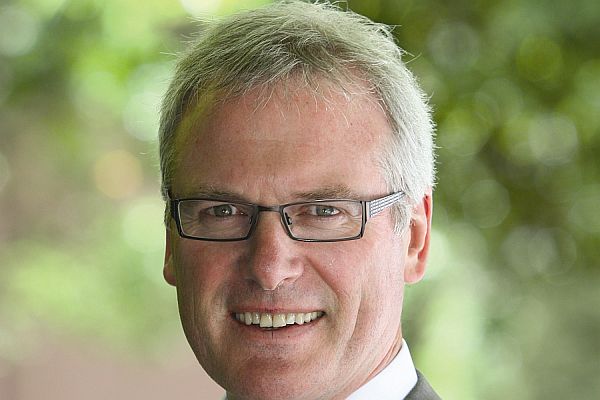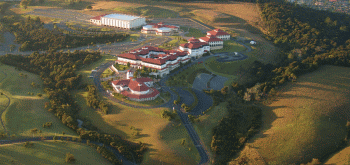Published on the 23/05/2011 | Written by David McNickel

Massey University’s Facebook page isn’t set up to allow ‘friends’, but according to Vice Chancellor Steve Maharey, creating partnerships is actually going to be the big secret for University success for the foreseeable future.
Steve Maharey doesn’t seem thrilled about his journey to visit Ngati Porou scheduled for after our interview – nothing to do with the people or agenda, he says, merely the tyranny of distance he’ll have to deal with to do it. The North Island’s east coast might well be the ‘first to see the sun’ – but it’s not an easy trip.
“Gisborne is impossible to get to,” he says, “It’s two flights in and out, all afternoon, all night and most of tomorrow morning to go to a two hour meeting. It’s exhausting. It takes up far too much of my time. There’s only one solution if you’re going to engage heavily through a country like this and around the world – you have to do it through good IT.”
As Maharey and the heads of universities around the world know, society’s demands of its tertiary education system are changing. The idea that a teenager will graduate from secondary, attend university for an undergraduate degree and be done with their education doesn’t fly any more.
“Those one-shot deals are over with,” he says. “The life-long learning model is clearly the big driver now.” But to accommodate that life-long learning he says the delivery model will have to be more flexible than it has ever been.
“Let’s say someone’s 40 years old, living in Taupo with two children and a mortgage, and their accountancy firm wants them to get their financial qualification back in shape.
They’re not going to have time for a three year BA or leave the family to study in Hamilton.
They’re maybe going to have time for a 16 week commitment, where we haul them in for a one week block course, or we go to them for a block course. And they have to be able to do this while they’re engaged at work.”
The challenge for Massey, he says, is to be able to deliver a learning environment in a scenario like this, that isn’t second rate. The ‘online learning’ model typically associated with modern day off-site education doesn’t really cut it he says.
“I am not a big fan. Online learning is just the old style of learning taking place online. You get sent some text.
You read the text. You write an essay back. This was never a good model of learning and it’s given the whole online learning environment a bad name.” Worse yet, Maharey says some countries won’t accept a qualification achieved this way – even in part.
“A lot of governments won’t accept a degree that has anything to do with online learning,” he says. “The Chinese, for example, won’t accept it if you have even one paper that was online – out of 21 – they’ll say no.”
But could this really just be a case of how you define ‘online’? At Open Polytechnic NZ (which has been educating extramurally since it started life as the Technical Correspondence School in 1946) communications director Doug Standish agrees that accreditation of qualifications between nations can be difficult at times – but this happens regardless of the mode of delivery. The dominant concern, he says, is really with “shonky non-accredited online ‘diploma mills’,” rather than legitimate institutions.
“High quality distance and online learning from reputable, accredited providers is very well accepted and growing around the world as a key driver of life-long learning – especially for adult learners in the workforce.”
Like Maharey, Standish sees ‘online’ today as moving towards a new model.
“Increasingly it’s being used to support classroom and campus-based teaching and it’s being used to enrich distance learning mainly based on other media.”
2020 Vision
So if it’s not traditional online, what exactly is Massey’s vision? Maharey describes it as ‘anywhere, anytime, anything’, an idea he’s adapting from TVNZ. “We have three campuses (Auckland, Wellington & Palmerston North), we operate in two countries (NZ and Singapore), there are lots of engagements we want to have – from Fonterra, to a local engineering firm, we’ve got students studying at a distance – basically we’re all over the place. So how do you control all that in an environment that is becoming increasingly disparate and disaggregated? The answer is a technological solution.”
He says the solution will include (but is no way limited to) enhanced service delivery via the web – enrollments, lecturer interaction, a teaching model that’s a blend of face to face and digital, the upheaval of the traditional semester system, high quality video conferencing, mobile solutions and super fast data. “Our researchers want to be able to exchange lots of data,” says Maharey. “They want to be able to move it around the world. They want to be in the field talking to business people, having access to the technology, not having to return to the office to work.
You should be able to do anything you want, at anytime on anything. That’s our vision.”
Whereas many business people tend to underestimate how long things are going to take, Maharey is refreshingly conservative when asked about timelines to achievement. “I don’t think we’ll get there in about 10 years,” he says, “but we have begun a robust investment package that will step us up to get a real platform for all that.” And why so long?
“It is overwhelmingly money,” he says, “but also just being cautious around not getting caught up. We could easily get besotted with the technology and forget that we don’t actually need it.
We need to know the purpose of it before we do it.”
And it’s on the subject of money that the idea of partnerships with business comes into sharp focus, but the exact nature of those alliances is something that business leaders will need to put considerable thought into – specifically around how they can add value to what Massey sees as its role in society – as opposed to simply what might be in it for the business. When examining the relationship between universities and business the world over, what’s clear is that universities don’t view the world like a business does – despite many hard-right economists thinking that they should.
In fact, when you boil it right down, universities actually do two things; 1) they instruct skills and produce graduates that society accepts as being verifiably competent at the types of work society needs done – lawyering, engineering, doctoring and so forth – and they do research.
Put more eloquently, as stated in the 1963 Robbins Report, universities ‘maintain research in balance with teaching, since teaching should not be separated from the advancement of learning and the search for truth.’
And interestingly, universities know (as it has been thoroughly researched by MIT and many others) that there is, in fact, a negative correlation between incentives (ie: being paid more) and producing good ideas (Google ‘the candle experiment’ for more information on that). According to the research, incentives such as money or other rewards work well when the process being incentivised is essentially mechanical ie: ‘the faster you attach these widgets the more we’ll pay you’. But cognitive skill improvement cannot be incentivised that way. Instead, cognitive improvements are best motivated intrinsically. So any company wishing to engage a university will need to present with an issue ‘that matters’ – something really important, both to the university and often to society at large.
Defining Value
Massey’s relationship with Fonterra is an excellent example of that concept in action. Maharey doesn’t describe Massey as ‘contracted to’, ‘hired by’ or ‘working for’ Fonterra.
Instead he talks about a “partnership” and a desire for a “formal relationship” – kind of like a marriage. And you don’t pay someone to marry you do you? That’s prostitution. Go too far down that track, he says, and you’re not a university anymore. Massey’s view of its purpose in engaging the business world is to create value, says Maharey, but he differs with primary funders the government on exactly what value is. “The government says it wants us to talk about ‘creating value’,” he says, “but when you ask them what they mean by value, they don’t know – they mean ‘more for less’ basically.
The government says it wants us to talk about ‘creating value’, but when you ask them what they mean by value, they don’t know – they mean ‘more for less’ basically.
Our model is certainly to create value and the way to do that is to engage with people so that they tell you – and hopefully the government – that there’s value here.” So what does that ‘engagement’ look like for Massey and Fonterra?
Maharey says the value in an agri-food based university and a dairying giant pairing up to work on “issues” is obvious and points to a work-in-progress in China triggered by the recent Sanlu (part Fonterra owned) baby food disaster. The issue there was illegally contaminated raw materials and an insecure supply chain and in essence what Massey is being tasked to do is secure a Chinese dairy production logistics chain “so when the product arrives on the shelf the buyer knows it’s okay and no one has fiddled with it.” To do this successfully is going to take a big IT investment, Maharey says, beyond what Massey can manage on its own. “There’s no way we could physically handle all that. This is big ticket stuff and we won’t pay for it out of our own money, but if it comes off it will be a real engagement with a real problem that would require us to have a lot of IT to be able to resolve the issue.”
Flying staff all over Asia isn’t possible he says, so the solution will have to be highly IT geared. “We’ll be connected to Hong Kong and there’ll be very good technology that will allow us to have control of the companies in the logistics line – from Hong Kong through to wherever the supermarkets are.”
And the partnership bottom line? Fonterra’s resources enable Massey to expand its agri-food bio security expertise, in turn delivering Fonterra a secure supply chain. “The way forward is to form partnerships,” says Maharey, “and we’re doing that with everybody we can lay our hands on now.”
The way forward is to form partnerships, and we’re doing that with everybody we can lay our hands on now.
It’s a philosophy that he’s keen to extend to Massey’s suppliers as well. Feel like pitching your wares to the organisation rated No.11 on the MIS list of New Zealand’s top 100 ICT users? If so, talk less, listen more and be prepared to bring plenty of IP to the table.
 Maharey refers to a presentation he attended recently with a Motorola executive visiting from the US, as a perfect illustration of how many technology vendors just aren’t getting where universities are trying to take education delivery. “Motorola have an ancient notion of what a classroom is,” he says.
Maharey refers to a presentation he attended recently with a Motorola executive visiting from the US, as a perfect illustration of how many technology vendors just aren’t getting where universities are trying to take education delivery. “Motorola have an ancient notion of what a classroom is,” he says.
“They talked about the classroom as being the focus of their technology because ‘the classroom is where learning takes place’. Our vision is anytime, anywhere because that’s actually how learning takes place.”
Although he says he was impressed with the demoed Motorola kit, that’s probably as far as the relationship will go.
“He’s arrived from America, lovely guy, very good presentation but I wouldn’t even bother ringing him. You could tell he just wanted to sell you the order book.
That’s no use. We want somebody who will spend time with us and we’ll know them in 10 years. Motorola really needs to sit down with some people who actually teach and ask them how they do it – rather than driving from the technology which is what they’re doing now.”
You Get What You Need
So what sort of skills are possessed by the 20,000 or so students who graduate with bachelor degrees from Massey and NZ’s other universities every year? And are they the skills the country needs? With an annual budget of around $3 billion allocated to tertiary education (plus another billion in loans and allowances), does the government get to decide what gets taught? The answer is not exactly, but.. yes.
Established in 2003, the Tertiary Education Commission actually allocates the funding. It’s a Crown entity and responsible to the Minister For Tertiary Education – that said, however, it does have independent statutory powers relating to the approval of government funding for universities.
Guidance for how this money gets spent comes via the Tertiary Education Strategy. Labour put one of these five year plans out in 2007, and after getting off to a warm fuzzy start it soon made it very clear what funding allocation would be tied to.
“The tertiary education sector’s role is to understand the needs of employers,” it states, “and seek to meet these. To achieve this it will be important that labour market information is taken into account at all levels of the tertiary education sector, both regionally and nationally.” At the Business Roundtable, executive director Roger Kerr says he wouldn’t argue that universities be exclusively focused on the needs of industry (he was on the council of Victoria University in the 90s), but he does agree with the needs assessment set out in the government’s strategy plan.
“I’d see the main mechanism of communication for vocational purposes,” he says, “as being the price signals of the employment market reflecting scarcity or abundance of graduate skills.” Translation? Skills that are scarce will be more in demand and therefore paid well, and so there will be demand from students for institutions to deliver the relevant courses. University chancellors are probably checking the situations vacant pages to see who and what employers are looking for.
Interestingly, National’s Tertiary Education Strategy revoked Labour’s in 2010. It basically carries the same message, although far less wordy and with plenty of belt tightening recommended.
So with business partnerships potentially underwriting research and government funding being directed strategically, are Massey and other NZ universities now equipped to successfully compete in the global tertiary education market? And more to the point, should they?
| MASSEY UNIVERSITY ICT PROFILE | |
| Desktop PCs | 5500+ |
| Laptops | 1000+ |
| Handhelds | 789+ |
| BUDGET FOR 2011 | |
| Computer Labs / Desktop Replacement | $2.9M |
| Disaster Recovery | $2.3M |
| IT Communications Infrastructure | $1M |
| Data Storage | $800,000 |
| Security Framework | $600,000 |
| IT Infrastructure Between Buildings | $600,000 |
Part of the answer depends on how you value the positive externalities of having an international footprint says Maharey. “I think this is one of the things that NZ probably hasn’t come to grips with yet. If we’re largely publicly funded institutions but we’re moving into becoming value creators around the world – either directly or indirectly – then a lot of our value to the country is simply that we are in China doing a good job and have done so for 30 years. That leads the Chinese to think ‘oh these New Zealanders are good people, a free trade agreement is a good idea’, partly because they’ve had contact with us for a long time and they think we’re alright.” In prestige terms, however, we’re up against big players when we head offshore Maharey admits.
Foreign governments clamour to be associated with ‘brand’ universities like Stanford and Oxford he says and “no NZ university has a name that’s anything like that.” The trick is to pick a niche and be world-beating at it. Massey has built an excellent name for itself in aviation, but it’s in the field of food technology that it has few equals. “We know we’re as good as anybody in that area,” Maharey says, “but we have to be able to back it. We have to be able to deliver on that promise and again, we’re going to have to do that with technology because we physically can’t be having staff going on a plane back and forth to Singapore all the time.” So will Maharey still be at the helm to see whether Massey delivers on the vision it’s outlined in its ‘Road To 2020’ strategy document? The answer… well, that depends. “The fashion in NZ seems to be that if you’re somewhere too long you must be boring and worn out so you should move off somewhere else and wear yourself out there. I am not sure that’s a great thing. That said, though, I think CEOs and their employers have to be hyper sensitive about when is the moment you have added your value to the organisation.
That may be five years, it may be 20 years – but you always have to be keeping your eye on it.”

































